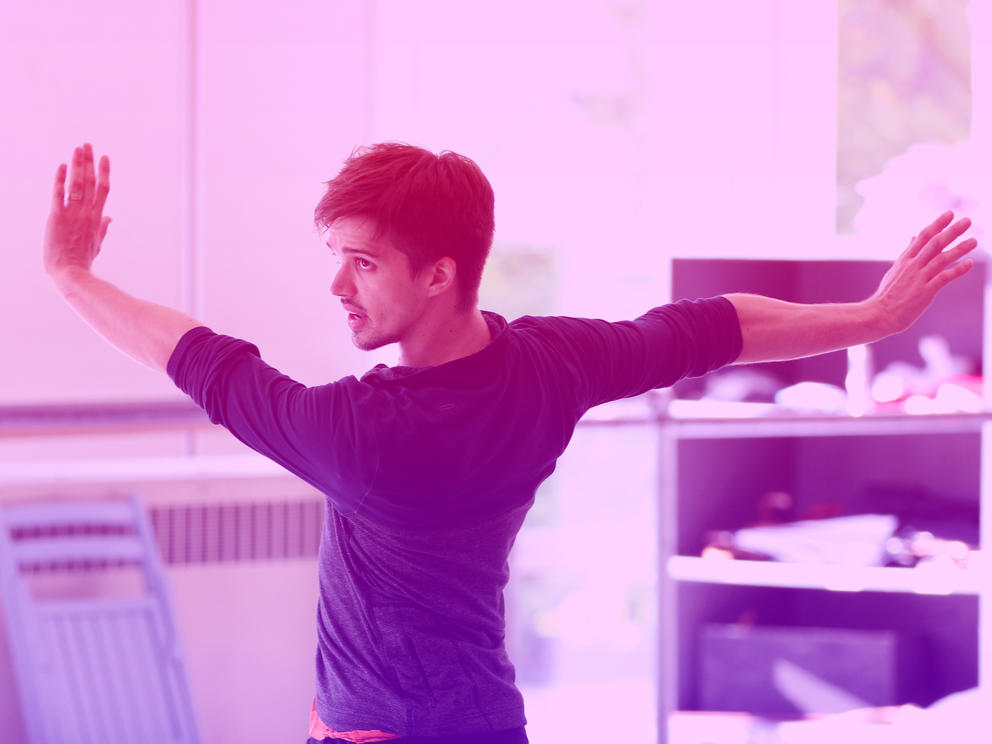Originally from Westfield, Indiana, Suddarth’s early entry into the arts was through musical theater. At 5 he already had his first professional gig, with the Center Stage Theater company in Texas.
At 15 he landed a role in The King and I that required dancing — and the choreographer was quick to tell him that even playing a hunting dog he needed dance lessons. Suddarth acquiesced, but having no interest in ballet, he took tap and jazz instead. When a ballet teacher at his dance school approached him and asked him to perform the title role in The Nutcracker he decided to try it — under one condition.
This interview is part of our Summer Artist Talks. Read more artist Q&As in the series.
“I said, ‘That’s fine, I’ll do ballet classes, I'll do your Nutcracker, but I won’t wear tights,’” Suddarth recalls. “I think I wore tux pants.”
After taking ballet classes for three months, he went on to a summer intensive at the Rock School for Dance Education in Philadelphia (“Of course, I had to wear tights,” he admits). Something had clicked.
He transitioned from traditional public high school to independent homeschooling so he could pursue dance for 12 hours a day, six days a week. He studied at various ballet schools — including at Pacific Northwest Ballet, where he was hired as an apprentice in 2010, promoted to the corps de ballet in 2011 and became a soloist in 2018. At PNB he also branched into choreography, creating pieces for mainstage, outdoors and online performances.
In addition to a ballet career, Suddarth, now 33, found love at PNB — ballerina Emma Love (now Suddarth), who has since retired. They didn’t get to perform together often due to their similar heights, but when they did, Suddarth says it was like “lightning in a bottle.”
When the pandemic hit, dance performance came to a standstill. But Suddarth’s restlessness led him to keep creating amid the global lockdown. Enter: a newfound interest in dance film.
Without really knowing how to use his Sony camera, he envisioned a 35-minute dance film that he would shoot, direct and edit. It premiered during PNB’s “digital” pandemic season. Entitled The Intermission Project, the nine-segment piece moves through distinct emotions, with dancers expressing sharp, rhythmic anxiety as well as soft, slow, articulated anticipation.
The film’s success led Suddarth to launch his dance film company, Jumpkut, in 2022. He also organized the first PNB Dance Film Festival, a collection of dance films from across the country that screened online. This year’s festival (Seattle Center, Aug. 5) features 12 short ballet films by directors based in Seattle and across the country.
Optimistic about the future of dance, Suddarth says ballet still holds “a poignant relevance” that can be amplified with film. “It can be in your phone and still resonate in a similar way,” he says. “We can bring dance into other things without lessening the art of it.”
Suddarth spoke with Crosscut about the language of dance, why Zoom is the best way for new choreographers to work and his newfound love for dance film.
This interview has been edited for length and clarity.
Crosscut: What do you enjoy about storytelling through dance?
Suddarth: Plays and musicals [have] a linear form of storytelling. But dance — all dance is a metaphor.
That’s why dance is, for me, so compelling — you have an extra element of rawness. Throughout the two-hour show, that person depletes themselves. They are physically becoming less and less capable throughout the entire show. That’s part of the character, the humanity you’re witnessing.
I’ve seen shows where, when the curtain comes down, the dancers literally fall to the floor and cannot stand up because every ounce of energy has been just depleted from their body. It gives a lot more weight to the story, which counteracts the fact that we don’t have dialogue and narration.
In addition to being a dancer, you’re a choreographer. During the pandemic, you had to choreograph over Zoom — what was that like?
I try to take a very specific emotional quality, or a question that I have. Then I try to base a work around that, and then I try to disguise it. COVID changed the way that I choreograph. I made 12 ballets during the course of that year, but I did it all from my basement, [which] has seven-foot ceilings, so I can’t stretch my arms above my head.
I got a different view than I would normally have in the studio. When you’re looking at Zoom, you can see an entire room at one time. It became a lot more about discussing things and being open-minded to dialoguing with the dancers.
Since COVID I have done a few other projects, and I’ve tried really hard to maintain that process, to pretend like I’m in my Zoom world. I have to just sit back and watch things unfold and really dialogue with the dancers.
I think that’s my challenge for any young choreographers just getting started: You should create a work via Zoom because it will change your entire perspective on how dance can be a more collaborative art form.
During the pandemic, you really dove into dance film. Was that an interest you had prior?
I had zero interest in dance film. I didn’t understand it. I didn’t like it. It felt like an additive to what we do on stage, and I felt like it was unnecessary.
A good friend of ours, Jenifer Ringer, and her husband ran, at the time, the Colburn [School] in LA. [Their students] were set to perform one of my pieces that my wife and I had staged earlier that year, but it got shut down [due to COVID-19]. She asked if in lieu of that I would be willing to do a film project.
I created something via Zoom with them — they recorded themselves at their homes, and they were in their living rooms and garages during rehearsals, knocking chairs over. It was a mess, but a very fun mess. They had a film editor who put the pieces together.
At the same time, the head of the dance department at the University of Oklahoma reached out to me. They wanted to do a film version of my piece Signature. We worked on that for six weeks, staging it via Zoom. They had an amazing film crew that came in with a crane and drones and all this stuff that I was not expecting, and they made this fantastic piece. That was an incredible experience, and I was like, “OK, there’s definitely more to this.”
You also worked on several dance films with the Kansas City Ballet during the pandemic. How did you bring what you learned to PNB?
I thought of this episodic idea that was sort of an á la carte offering: short, bite-sized pieces that could be appreciated in shorter sections or the whole thing.
I wanted to make nine films for PNB, and each film could be cut down into one of three acts or each film by itself. [This became known as The Intermission Project.] I presented this idea to Peter Boal, PNB’s [artistic] director, and he jumped on it immediately.
That whole idea was: I would choreograph it, I would film it myself, I would edit it myself. I will deliver the package — I just want to explore and experiment.
[After] A lot of YouTube videos, learning how to use my camera, I crossed my fingers and hoped that it would turn out well. It ended up being great.
How does making dance films feel different from making dance?
Getting in there and capturing my choreography with the camera gave me the chance to be a part of the performance, allowing me to put the audience’s eyes where I wanted them. [Dance film is] an immersive experience, as opposed to stage dance, which is a performative experience. I loved being able to direct the audience perspective at the same time as directing the dancers’ movements.
That’s when I started to realize the value of dance film. You really have to be focused on — whether it’s narrative or not — what is the story you’re telling, what is the arc? You’re putting the audience member in the middle of something, what is it and why?
So much goes into these really simple moments in dance film. You have to get the lighting, the setting, the exposure and then you have to edit it in a precise way so that it is inescapable that you feel this thing, whatever it is, which I loved.
It sounds like you’re not scared of embracing new technologies and integrating them with dance.
You have to remember that Sleeping Beauty — powdered wigs, big skirts, tutus, the epitome of classical ballet — was once a cutting-edge work. [It premiered in 1890.] Sleeping Beauty was a rock concert … the epitome of everything new when it happened.
There are people throughout history who have embraced new things in dance, and it’s like, “Oh, wait, this isn’t what we do. This is threatening our way of doing dance.” People thought that about George Balanchine, and people thought that about Bill Forsythe.
Things that are really groundbreaking were unthinkable before they happened. I think as we look at new technologies, new ways of experiencing and enhancing this art form, you can’t be afraid of it.
There is space in dance to continue making new, exciting things that are made for a contemporary audience.
Speaking of new approaches to dances, you recently launched a new dance film company, Jumpkut. Why?
I stewed on it for quite a while, thinking, well, Why would I have a company? Obviously, there’s a great ballet company in Seattle, but there’s also great contemporary companies — Whim W’him, Spectrum. I didn’t want to make a carbon copy of any of those. I wanted to do something different.
Jumpkut is really my opportunity to [pursue] big projects … things that push dance beyond our normal perspective on it to bring it to a contemporary audience. [It’s] creating a space where I can tackle projects that take two, three, even five years to come to fruition.
We’re not changing dance — dance is fine — but presenting it in ways that are exciting and fresh and new.
You’ve been a working artist in Seattle for 14 years. What’s a particular challenge for the local arts scene?
The reasons Seattle has become this tech hub [are] the same reasons we have so many dance and arts things that pop up: because there is a real interest in creating things. It’s culturally just part of the fabric of Seattle. Harnessing [that creative element] for our purposes is the challenge.
By continuing to create things that are beautiful and compelling, and continuing to try and reach people through the spectacle of theater and film, but also through the emotional aspect of what we can do. This can be just as exciting and compelling as a Marvel movie.
Get the latest in local arts and culture
This weekly newsletter brings arts news and cultural events straight to your inbox.



